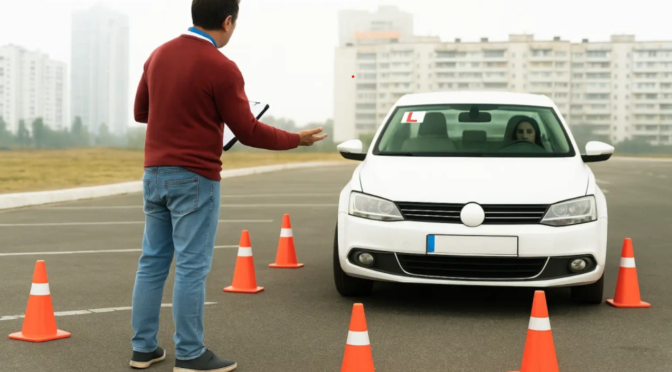Learning to drive is a significant milestone, but many beginners fall prey to widely held driving myths. Believing in these misconceptions can negatively affect confidence, decision-making, and safety on the road. Whether you are enrolled in a driving school in Prestons, attending driving classes in Prestons, or learning from a professional driving instructor Prestons, it is essential to understand the facts. Below, we explore 16 common driving myths and debunk them with expert insights.
1. Red Cars Get More Tickets
A prevalent myth is that red cars attract more speeding tickets. Many assume law enforcement targets flashy or bright vehicles, but in reality, a car’s color has no bearing on ticketing. Enforcement is based on behavior, speed, and adherence to traffic laws rather than aesthetics. For beginners, this myth can create unnecessary anxiety about vehicle choice.
When you attend driving classes in Prestons, instructors emphasize the importance of safe and responsible driving rather than worrying about superstitions like color. A professional driving instructor Prestons will guide learners to focus on skills, awareness, and reaction time instead of unfounded fears. Choosing a red, blue, or any other color car should depend on personal preference, comfort, and familiarity, particularly when preparing for a driving test.
Additionally, enrolling in a driving school in Prestons ensures you receive evidence-based education that debunks myths like this. Through lessons, you will learn that ticketing is determined by how you drive, not by what you drive. Understanding these facts early in your learning journey builds confidence, allowing you to concentrate on developing proper driving techniques, safe decision-making, and defensive driving habits. The emphasis should always be on preparation, practice, and adherence to traffic laws rather than worrying about irrelevant factors like car color.
2. Pumping Brakes in an Emergency
Another common misconception is that drivers should pump the brakes during an emergency stop. This advice applied to older vehicles without Anti-lock Braking Systems (ABS), but modern cars are equipped with ABS that function differently. Pumping the brakes in vehicles with ABS can actually reduce braking efficiency and make it harder to maintain control during sudden stops.
When attending driving classes in Prestons, learners are trained in correct emergency braking techniques specific to modern vehicles. A driving instructor Prestons will demonstrate how to apply firm, steady pressure on the brake pedal, allowing ABS to optimize stopping distance while preventing wheel lock. This knowledge is crucial, particularly in high-stress situations where instinctive actions could compromise safety.
Professional driving schools in Prestons ensure students understand vehicle mechanics alongside practical driving skills. By practicing controlled emergency stops under the guidance of a qualified instructor, learners can develop muscle memory and confidence, making them more prepared for real-life scenarios. The myth of pumping brakes is not just outdated—it can be dangerous if followed blindly. Educating learners on modern braking systems emphasizes the importance of keeping updated with vehicle technology and learning correct responses for different driving conditions.
3. Hands-Free Devices Are Completely Safe
Many learners believe using hands-free phones while driving is safe. While hands-free devices free up your hands, they do not eliminate cognitive distraction. Even minor phone conversations can slow reaction time, impair judgment, and increase accident risk. This is a common misconception among both new and experienced drivers.
During driving classes in Prestons, instructors highlight the dangers of distractions, including hands-free phone use. A skilled driving instructor Prestons will provide real-life examples and exercises to help learners recognize how divided attention affects driving performance. The focus is on situational awareness, maintaining focus on the road, and developing habits that minimize distractions.
Enrolling in a driving school in Prestons offers structured guidance to break habits that may seem harmless but can be risky. Instructors often teach strategies such as using voice-activated navigation, setting phones on silent, or pulling over safely for urgent calls. Understanding that hands-free does not equal risk-free is critical for fostering responsible driving behavior. This myth debunking reinforces the broader lesson that safety depends on attentiveness, not just technology. By internalizing these lessons, learners can cultivate safer driving practices that last a lifetime.
4. Bigger Vehicles Are Always Safer
It’s a common assumption that larger vehicles, like SUVs or trucks, are inherently safer than smaller cars. While size can offer some protection in collisions, bigger vehicles come with challenges such as higher rollover risk, larger blind spots, and reduced maneuverability. Believing in this myth can lead learners to overestimate safety and underestimate hazards.
In driving classes in Prestons, instructors emphasize that safety is a combination of vehicle control, awareness, and adherence to traffic rules, rather than size alone. A driving instructor Prestons will guide learners on how to handle larger vehicles safely, including managing blind spots, braking distances, and cornering techniques. Skills taught in a driving school in Prestons focus on defensive driving and hazard anticipation, ensuring learners understand that a vehicle’s size cannot replace safe driving habits.
For new drivers, choosing a vehicle that matches their comfort level is far more important than its size. Proper training ensures that drivers can confidently manage any car, whether compact or large. Understanding the limitations and handling characteristics of your vehicle helps prevent accidents and improves overall road safety. Debunking this myth encourages learners to focus on skills and awareness, which are the true determinants of safe driving.
5. Seatbelts Are Optional on Short Trips
Many beginners believe that short drives don’t require seatbelt use. In reality, most accidents happen close to home, making seatbelt use essential at all times. This myth can lead to risky behavior and serious injuries in minor collisions.
Professional driving schools in Prestons teach the importance of consistent seatbelt use. During driving classes in Prestons, instructors stress that seatbelts are the single most effective safety feature, reducing the risk of fatality in accidents. A driving instructor Prestons can demonstrate proper seatbelt positioning and discuss real-life cases where short trips led to injuries, reinforcing the habit of always buckling up.
Consistent seatbelt use is a fundamental part of defensive driving and is often emphasized in practical driving lessons. Developing this habit early ensures long-term safety, regardless of trip length. Debunking myths like this is a key aspect of training at driving schools in Prestons, helping learners cultivate responsibility, awareness, and safe driving practices from day one.
6. You Can Rely Solely on GPS
Many learners think GPS devices eliminate the need for situational awareness. While useful, GPS can be outdated, inaccurate, or fail to account for sudden hazards. Overreliance on technology can compromise decision-making and reaction time.
In driving classes in Prestons, instructors teach learners to combine GPS use with observation, hazard assessment, and defensive driving. A driving instructor Prestons encourages students to continuously scan the road, anticipate obstacles, and make independent decisions, regardless of GPS instructions.
Driving schools in Prestons reinforce that situational awareness is paramount. Practical exercises simulate navigation challenges to train learners to adapt when GPS fails or instructions are unclear. Debunking this myth ensures that new drivers develop critical thinking skills behind the wheel and understand that technology is a tool, not a substitute for responsible driving.
7. You Don’t Need to Warm Up Your Car in Winter
Some learners believe vehicles need extensive warm-up periods in cold weather. Modern engines are designed to operate efficiently without prolonged idling. Excessive warm-up wastes fuel and contributes to pollution.
Driving classes in Prestons and driving instructors Prestons provide guidance on efficient winter driving. They teach that gentle driving immediately after starting the engine is sufficient while avoiding high RPMs until the engine reaches operating temperature.
Driving schools in Prestons also cover winter safety tips, including tire checks, de-icing strategies, and hazard anticipation. Debunking this myth encourages learners to adopt fuel-efficient, safe practices, emphasizing that modern vehicles require minimal idle time while maintaining performance and safety in cold conditions.
8. Automatic Cars Are Easier for Everyone
Automatic vehicles are simpler to operate, but ease of use doesn’t eliminate the need for comprehensive training. Learners must still develop traffic awareness, hazard response, and parking skills.
Driving classes in Prestons provide complete instruction for both automatic and manual vehicles. A driving instructor Prestons ensures students master essential skills like lane changing, intersection navigation, and defensive driving, regardless of transmission type.
Enrolling in a driving school in Prestons guarantees structured learning. Debunking the myth that automatics require less effort reinforces the importance of skill development over reliance on simplified controls. Proper guidance ensures learners are competent, confident, and safe drivers.
9. Braking Distance Doesn’t Change With Speed
Many beginners believe stopping distance is constant, regardless of speed. In reality, higher speeds require longer distances to stop safely due to momentum and reaction time. Misjudging braking distances is a frequent cause of accidents.
Driving classes in Prestons teach learners to calculate safe following distances and adapt speed to conditions. A driving instructor Prestons provides demonstrations and practical exercises showing how braking distances increase with speed and road conditions.
Driving schools in Prestons emphasize defensive driving techniques, helping learners anticipate stopping needs and maintain safe gaps. Understanding this principle is vital for avoiding collisions and making informed driving decisions.
10. Hands Must Be at 10 and 2 on the Wheel
Old guidelines suggested holding the steering wheel at 10 and 2. Modern safety recommendations advise 9 and 3 for better airbag protection during collisions. Following outdated practices can reduce safety effectiveness.
Driving classes in Prestons teach current, evidence-based steering techniques. A driving instructor Prestons provides hands-on guidance to ensure learners adopt proper posture and grip.
Driving schools in Prestons reinforce modern safety standards, including hand placement, seat position, and mirror adjustment. Debunking this myth ensures learners practice ergonomically correct and safe steering habits.
11. You Can Drink Small Amounts and Drive Safely
Many assume small amounts of alcohol don’t impair driving. Even minimal alcohol can slow reaction time, reduce judgment, and increase accident risk.
Driving instructors Prestons emphasize a zero-tolerance approach for learners. Driving classes in Prestons include education on alcohol effects, legal limits, and consequences of impaired driving.
Driving schools in Prestons promote responsible habits and demonstrate real-life scenarios where even small amounts can be dangerous. Debunking this myth encourages lifelong safe driving practices.
12. Daytime Driving Is Always Safe
Some learners believe daytime driving is inherently safe. Accidents can happen at any time, and factors like glare, weather, and traffic density can affect safety.
Driving classes in Prestons teach strategies for managing visibility, anticipating hazards, and adjusting speed. A driving instructor Prestons provides practical exercises under different lighting conditions.
Driving schools in Prestons reinforce the importance of vigilance at all times, highlighting that time of day does not replace attention or skill.
13. Passing the Test Means You’re Fully Prepared
Passing a driving test is only the beginning. Many learners assume they are fully prepared for all situations, but real-world driving requires continuous experience and learning.
Driving instructors Prestons encourage post-test practice, defensive driving, and ongoing skill refinement. Driving classes in Prestons emphasize experience in varied road conditions.
Driving schools in Prestons promote the mindset that safe driving is lifelong learning. Debunking this myth helps learners stay humble, cautious, and committed to improvement.
14. You Don’t Need Car Maintenance Until Something Breaks
Neglecting regular maintenance can compromise safety and vehicle reliability. Worn brakes, tires, or lights increase accident risk.
Driving classes in Prestons and driving instructors Prestons teach basic vehicle care and the importance of preventative maintenance.
Driving schools in Prestons encourage learners to monitor tire pressure, fluid levels, and brakes, promoting safety and reducing long-term costs.
15. Green Lights Always Mean Go
Many beginners assume green signals guarantee safety. Intersections can still be hazardous due to other drivers, pedestrians, or obstructions.
Driving classes in Prestons teach learners to approach all signals cautiously. A driving instructor Prestons reinforces scanning intersections before proceeding.
Debunking this myth encourages situational awareness and prevents accidents caused by overconfidence.
16. New Tires Only Matter in Wet Conditions
Some believe tire quality is only important in rain. In reality, worn tires affect braking, cornering, and stability in all conditions.
Driving schools in Prestons teach the importance of checking tread depth and replacing tires as needed. Driving classes in Prestons include demonstrations of tire grip and handling. A driving instructor Prestons highlights safety benefits of maintaining proper tires.
Understanding this myth ensures learners prioritize vehicle safety year-round.
Conclusion
Driving myths can mislead new drivers and compromise safety. Whether attending a driving school in Prestons, enrolling in driving classes in Prestons, or learning from a driving instructor Prestons, it is vital to separate fact from fiction. By debunking myths about brakes, seatbelts, alcohol, GPS, and more, learners develop safe, confident, and responsible driving habits. Knowledge, practice, and expert guidance form the foundation of lifelong road safety.
 0405 477 217
0405 477 217




 Enquire Now
Enquire Now








